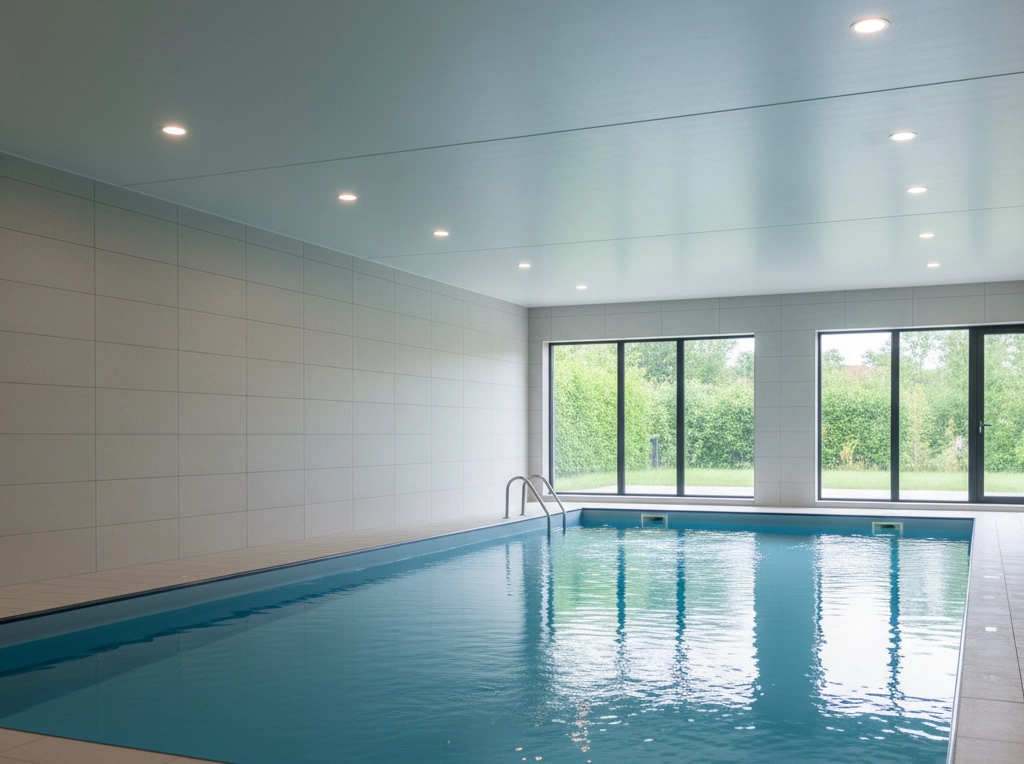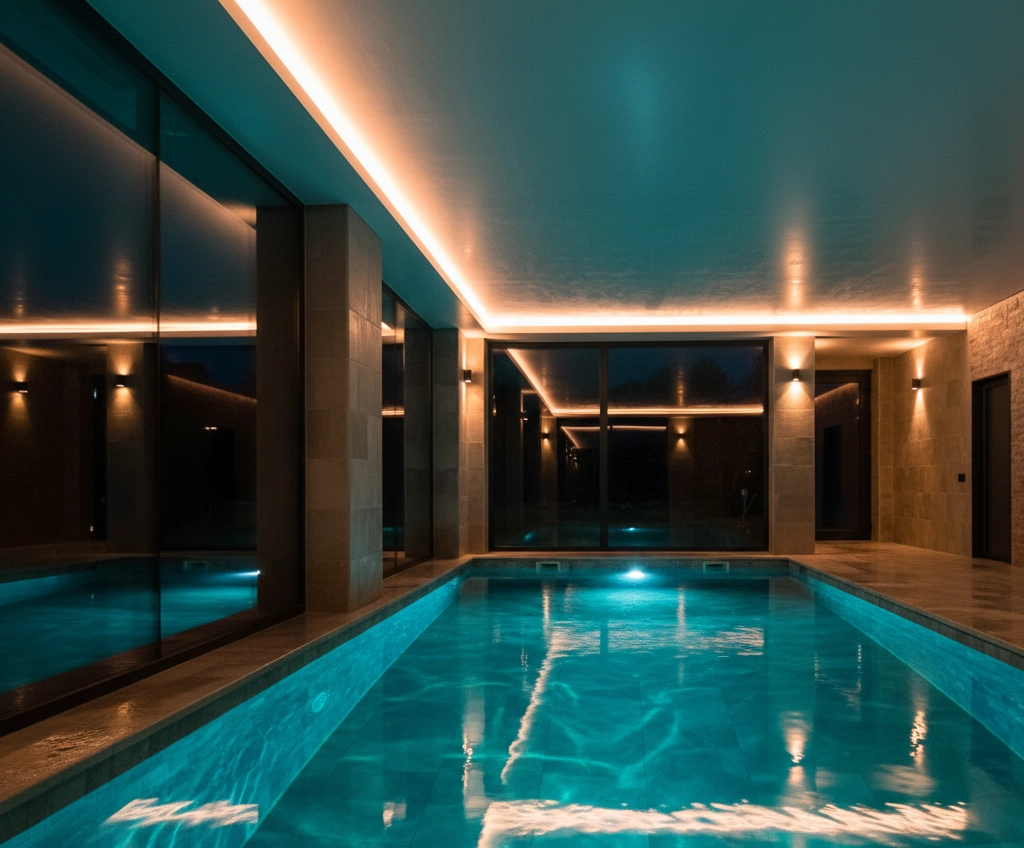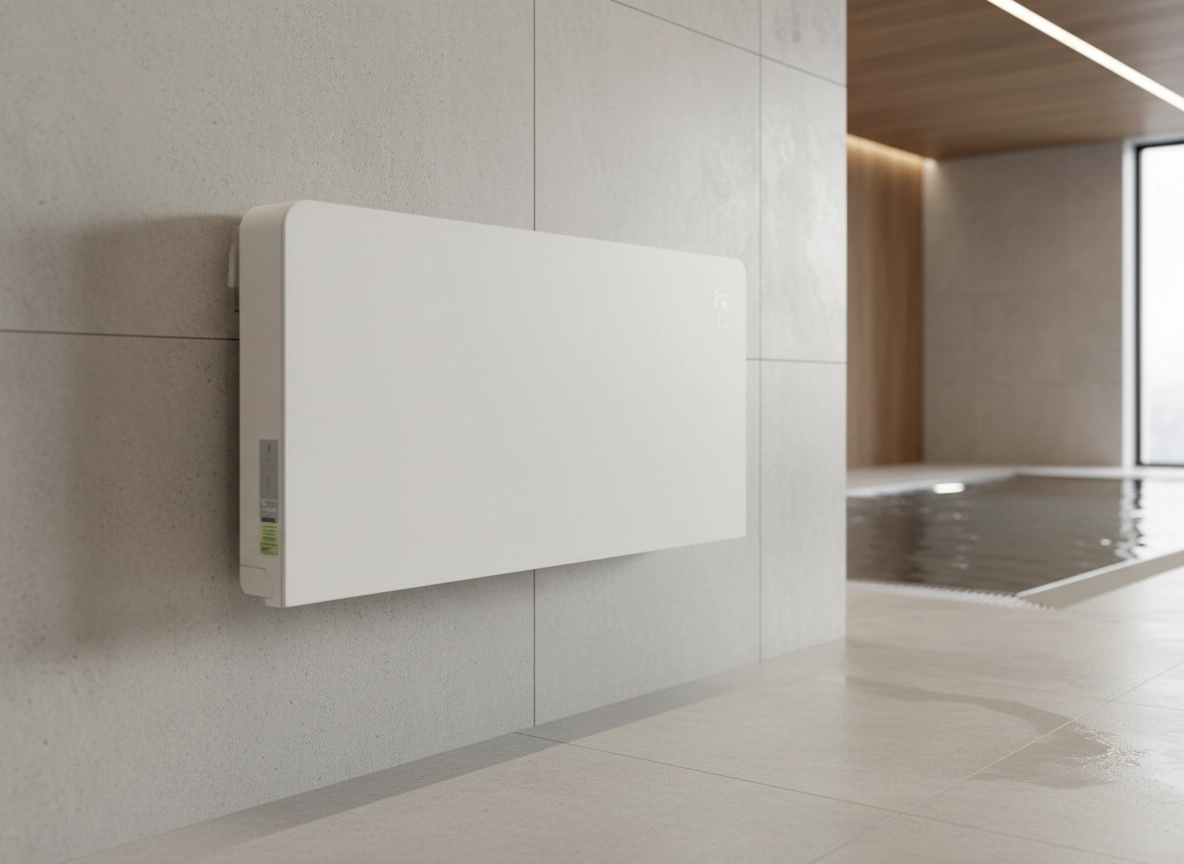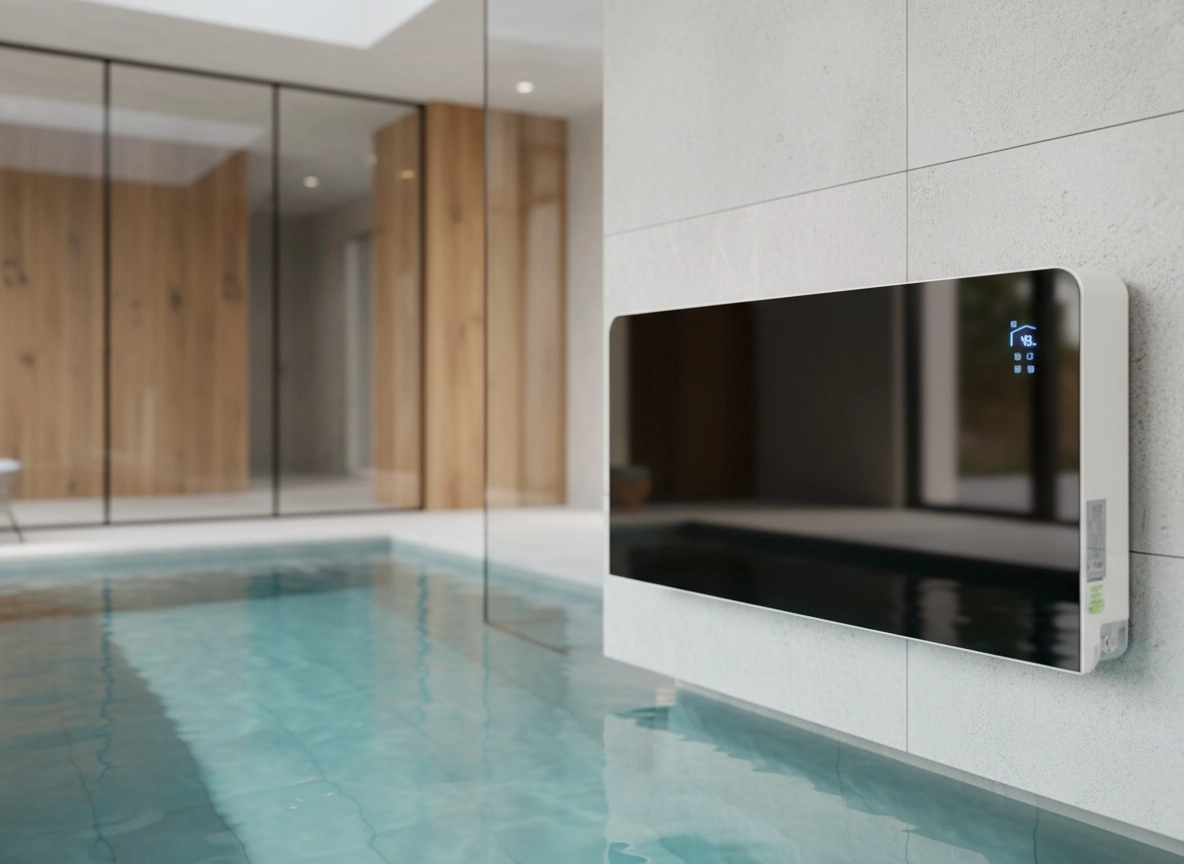
One of the most common mistakes pool owners make is turning on the dehumidifier only when condensation appears on windows and walls and switching it off at night. It may seem logical not to waste electricity when no one is using the pool, but this mode leads to constant wetting cycles, high humidity, and even structural damage. Water evaporates from the pool around the clock (4–5 liters from every square meter of water surface per day), so humidity rises quickly. In the morning you have to deal with condensation, and the dehumidifier is forced to run at maximum power to bring humidity down to a comfortable 50–60%.

How long the dehumidifier should run depending on the situation
The optimal operating mode depends on specific pool usage conditions. Let's review the main scenarios and recommendations.
Continuous operation on first start-up: 48–72 hours
On the first start-up or after a long break, humidity is usually 80–90%. This is far above the optimal range of 50–60%. In this case, the dehumidifier should run continuously for 48–72 hours to bring humidity down to a comfortable level. During this period, the unit operates at maximum capacity, removing up to 53–108 liters of moisture per day (depending on the model).
If you turn the dehumidifier off during this period, drying will be constantly interrupted and normalizing the microclimate may take weeks. The result is persistently high humidity, condensation, discomfort, and potential damage to finishes.
Active daily use: 24/7 mode
With daily pool use, water evaporation is continuous at 4–5 liters per square meter of water surface per day. This process does not stop at night — evaporation continues 24 hours a day, 7 days a week.
In this mode, the dehumidifier should run around the clock. Modern models are equipped with humidistats that automatically control the compressor: it switches on when humidity exceeds the setpoint (usually 55–60%), and switches off once the target is reached.
Thanks to automation, the compressor does not run constantly — it is active about 12–16 hours per day, with the remaining time spent monitoring. This ensures an optimal microclimate and saves equipment life.
Occasional use 1–2 times a week: timer operation
If the pool is used only 1–2 times a week, you can set the dehumidifier to run on a timer. An optimal schedule is 8–12 hours per day. For example, run 2 hours every 6 hours or 4 hours in the morning and 4 in the evening.
This setup maintains optimal humidity while saving electricity. However, it is important to check the actual humidity regularly and adjust the schedule if needed.
Winter layup: minimal operation
Even if the pool is not used in winter, you should not switch the dehumidifier off completely. Set a minimal operating mode — 2–4 hours per day. This prevents mold and mildew, which can appear within 2–3 weeks in high humidity.
The optimal solution is to set the humidistat to keep humidity no higher than 65%. This way the dehumidifier activates only when this threshold is exceeded, ensuring minimal power consumption.

Is it okay to let a dehumidifier run 24/7?
One of the most frequently asked questions by pool owners is whether it's safe to run a dehumidifier around the clock. The answer: yes — not only is it safe, it's recommended.
Professional pool dehumidifiers are industrial-grade equipment specifically designed for continuous operation. They are equipped with all necessary protection systems:
- Compressor overheat protection
- Refrigerant pressure monitoring
- Leak protection
- Automatic condensate drainage
- Drain system overflow protection
Water evaporates from the pool 24/7, even at night. If you switch the dehumidifier off overnight, humidity can rise by 10–15% by morning, causing condensation on cold surfaces.
Modern dehumidifiers with automation work in cycles: the compressor activates when humidity rises and turns off when the target level is reached. On average, the compressor runs 12–16 hours per day in active dehumidification, with the rest spent monitoring. This operating principle greatly extends compressor life compared to manually switching the unit on and off.
Can you leave it running at night?
Yes, you can and should leave the dehumidifier running at night, with one important condition — low noise. Noise is the main reason owners switch dehumidifiers off at night.
Standard dehumidifiers produce 55–65 dB, comparable to a vacuum cleaner or a loud conversation. That noise can disturb sleep, especially if the pool is near living spaces.
The solution is to use quiet models with 40–50 dB. For example, MBA-G series dehumidifiers are just 44 dB for MBA05G and MBA07G, and 46 dB for MBA10G. This is achieved thanks to a low-noise DC fan motor.
For comparison, 44 dB is quieter than a whisper (30–40 dB) or gentle rain (40–50 dB). This level does not disturb sleep, so an MBA-G dehumidifier can safely run overnight even when the pool is next to a bedroom.
If you already have a noisy dehumidifier, there are several solutions:
- Install the dehumidifier in a separate mechanical room
- Add sound insulation
- Use a timer for a night schedule (not ideal from a humidity-control standpoint)
Operating modes by situation
| Situation | Operating mode | Run time | Why |
|---|---|---|---|
| First start-up | Continuous | 48–72 hours | Reduce initial humidity from 80–90% to 50–60% |
| Active daily use | 24/7 with automation | Around the clock | Continuous water evaporation (4–5 L/m² per day) |
| Use 3–4 times a week | Automation + timer | 16–20 hours per day | Regular but not daily evaporation |
| Use 1–2 times a week | Timer | 8–12 hours per day | Intermittent evaporation |
| Winter layup | Minimal mode | 2–4 hours per day | Prevent mold and mildew |
| After flooding or an incident | Maximum power | 24 hours, until normalized | Rapid removal of excess moisture |
| During repair or painting | Boost mode | 24 hours | Fast drying of materials, prevention of mold growth |
| At high humidity (>75%) | Maximum power | Until within range | Bring humidity down to a safe level |
| Pool in a living area (quiet model) | 24/7 with automation | Around the clock | Low noise does not disturb rest |
| Pool in a separate building | 24/7 with automation | Around the clock | Constant humidity control to prevent damage |
Notes:
- With 24/7 operation and automation, the compressor cycles on only when humidity rises above the set level.
- You can set the timer on the dehumidifier control panel or via a mobile app for "smart" models.
- During layup, air temperature should be above 10°C for proper dehumidifier operation.
How to configure automation for the optimal mode
Proper automation settings are key to efficiency and energy savings. Here are the main parameters to consider.
Setting the target humidity
The optimal relative humidity for pool rooms is 55%. The acceptable range is 50–60%.
Setting humidity below 45% leads to excessively dry air, which can cause discomfort: dry skin, irritated mucous membranes and eyes. The dehumidifier will also run constantly trying to reach an unrealistic humidity level in a pool environment.
If you set it above 65%, you risk condensation on cold surfaces and mold and mildew growth.
Humidistat settings
A humidistat measures humidity and controls the dehumidifier. It works as follows:
- Measures humidity every 5–10 minutes
- Turns the compressor on when humidity exceeds the setpoint (e.g., 55%)
- Turns the compressor off when humidity reaches the target
This ensures optimal operation, activating the unit only when needed, saving electricity and extending compressor life.
Using the timer
For pools used intermittently, it makes sense to set a run timer. For example:
- Run 2 hours every 6 hours (for low-intensity use)
- Run 4 hours in the morning + 4 hours in the evening (for occasional use)
- Run 20:00–08:00 at low fan speed (night mode)

Smart control for MBA-G
Modern MBA-G dehumidifiers offer advanced control options:
- Real-time humidity monitoring via mobile app
- Humidity trend charts for performance analysis
- Alerts when thresholds are exceeded
- Remote control of operating modes
The system allows you to choose different power modes:
- High — for rapid drying during first start-up or after intensive pool use
- Medium — for daily use
- Low (night) — for quiet nighttime operation
- Auto — the system selects the optimal power based on humidity level
Common mistakes in operating modes
Pool owners often make mistakes when using dehumidifiers. Here are the six most common.
1. Turning it on only when condensation appears
Many owners switch the dehumidifier on only when they already see condensation on windows or walls. This reactive approach fights the symptoms rather than the cause.
A dehumidifier should run continuously in a preventive mode, maintaining optimal humidity. This prevents condensation and related issues: mold growth, damage to finishes, and corrosion of metal parts.
2. Switching it off at night
Turning the dehumidifier off at night to save energy is a common mistake. Over 8 hours, humidity rises by 10–15%, and in the morning the unit must run at maximum to normalize the microclimate.
In fact, cycling through the night (periodic on/off) is more economical than intensive morning operation at full power. Plus, constant humidity swings damage structures and finishes.
3. Setting the target humidity too low
Setting a target of 40% or lower is a common mistake. This forces the dehumidifier to run at maximum continuously, because such a low level is nearly unattainable in a room with an open water surface.
The result is higher electricity use, accelerated wear, and discomfort due to overly dry air. The optimal value is 55% (range 50–60%).
4. Manual control instead of automation
Some owners ignore built-in automation and switch the dehumidifier on and off manually. As a result, the unit is often forgotten off, or left running at full power when not needed.
Automation (humidistat and timer) ensures optimal operation by activating the compressor only when necessary. This saves electricity and equipment life.
5. Switching it off completely in winter
Completely turning the dehumidifier off in winter when the pool is unused is a serious mistake. Even a covered pool continues to evaporate, and without dehumidification mold can appear within 2–3 weeks.
The optimal solution is a minimal operating mode (2–4 hours per day) or setting the humidistat to maintain humidity no higher than 65%.
6. Constant operation at maximum power
Some owners think maximum power equals maximum efficiency and keep the dehumidifier in this mode all the time. This accelerates compressor wear and increases energy use.
The optimal approach is automatic power regulation based on humidity. Maximum power is needed only for quick humidity reduction, for example at first start-up or after intensive pool use.
Saving electricity with 24/7 operation
Many pool owners worry about electricity costs when running a dehumidifier around the clock. Let's look at real consumption and ways to optimize it.
Real-world MBA-G consumption
Nominal power of MBA-G dehumidifiers:
- MBA05G: 0.89 kW (nominal), 1.89 kW (maximum)
- MBA07G: 1.09 kW (nominal), 2.09 kW (maximum)
- MBA10G: 1.95 kW (nominal), 2.7 kW (maximum)
However, real consumption is significantly lower because the dehumidifier runs in cycles. A typical cycle: 30 minutes on, 20 minutes off. Thus, the average draw is about 0.5–0.6 kW for the MBA05G, which is 60–70% of nominal.
Daily consumption calculation
When the MBA05G runs 24/7, the compressor is active for about 14 hours per day, with the rest in monitoring. Consumption calculation:
14 hours × 0.89 kW = 12.5 kWh per day
Per month this is approximately 375 kWh.
For comparison, other appliances consume:
- Electric heater: 1.5–2 kW continuously
- Air conditioner: 1–3 kW in active mode
- MBA-G: 0.5–0.9 kW average load
How to reduce electricity consumption
There are several ways to reduce dehumidifier energy use:
- Cover the pool when not in use. This reduces evaporation by 30%.
- Set an optimal target humidity — 55%, not 40%. This reduces dehumidifier load.
- Clean filters regularly. Dirty filters increase fan and compressor load, raising consumption by about 15%.
- Ensure good ventilation. A combination of dehumidification and ventilation is more effective than running only the dehumidifier at maximum.
Comparing savings from switching off at night:
If you turn the dehumidifier off for 8 hours, you save 4–6 kWh. But in the morning the unit will run at maximum for 3–4 hours to normalize humidity, consuming an additional 3–5 kWh. The real savings are minimal, while the risk of condensation, mold, and corrosion increases.
Why MBA-G is designed for 24/7 operation
MBA-G dehumidifiers have several features that allow efficient round-the-clock operation.
Low noise level
The main advantage of MBA-G is low noise: 44 dB for MBA05G and MBA07G, 46 dB for MBA10G. This is achieved thanks to a DC fan motor.
By comparison, standard dehumidifiers are 55–60 dB. 44 dB is quieter than a whisper or gentle rain, so MBA-G can safely run overnight even if the pool is next to a bedroom.
Corrosion protection
The aggressive pool environment (high humidity, chlorine vapors) can ruin ordinary dehumidifiers within 2–3 years of continuous operation. MBA-G features a golden epoxy-coated heat exchanger with anti-corrosion properties, so service life exceeds 10 years in 24/7 operation.
Smart automation
The built-in humidistat works in cycles, saving the compressor and keeping humidity stable without swings. The system monitors humidity and activates the compressor only when needed.
Model range for different pools
MBA-G comes in three models for different pool areas:
- MBA05G: capacity 53 liters per day, for pools up to 22 m²
- MBA07G: capacity 84 liters per day, for pools 22–35 m²
- MBA10G: capacity 108 liters per day, for pools 35–50 m²
Choosing the right model ensures effective 24/7 operation without overloading the equipment.

FAQ: answers to the most popular questions
How many hours per day should a pool dehumidifier run?
With active pool use — 24 hours a day with automation. The compressor cycles, running about 14–16 hours per day, with the rest spent monitoring. With periodic use, 12–16 hours per day on a timer is sufficient.
Is it safe to leave the dehumidifier on when no one is home?
Yes. Modern dehumidifiers are designed for autonomous operation and equipped with protections against overheating, leaks, and overflow. It is perfectly safe to leave them running unattended. Moreover, maintaining optimal humidity continuously prevents condensation and mold.
What happens if you switch the dehumidifier off at night?
In 8 hours off, humidity in the room will rise by 10–15%. In the morning you'll see condensation on windows and cold surfaces, and the dehumidifier will need 2–3 hours at maximum power to restore normal humidity. It is more effective to maintain stable humidity by cycling through the night.
How often does the dehumidifier cycle in automatic mode?
A typical cycle is 30–40 minutes of compressor operation, then 15–25 minutes off once the target humidity is reached. The exact frequency depends on evaporation intensity and room size. On average, in stable conditions, the compressor activates 2–3 times per hour.
Should I switch the dehumidifier off in winter if the pool is not used?
No. A minimal operating mode is required because mold can appear after just 2–3 weeks of downtime. Set a timer for 2–4 hours per day or set the humidity threshold at 65%. This protects the space with minimal electricity use.
Is MBA-G loud at night?
No. MBA-G noise is only 44–46 dB, comparable to gentle rain. Thanks to the DC fan motor, it runs very quietly and does not disturb sleep even if the pool is near a bedroom.
How much electricity does the dehumidifier use when running 24/7?
When running 24/7, MBA-G typically consumes:
- MBA05G: 10–15 kWh per day
- MBA07G: 12–18 kWh per day
- MBA10G: 18–25 kWh per day
Actual consumption depends on evaporation intensity and compressor cycling.
Can I set different modes for day and night?
Yes, if the dehumidifier has a programmable timer or smart control. For example, you can set a 60% target during the day and 55% at night for less intensive operation. However, in most cases a single 55% setting with automation is sufficient, and the system will regulate operation as needed.
Conclusion
For an actively used pool, the optimal dehumidifier mode is 24/7 with automatic regulation. This ensures a stable microclimate, prevents condensation and mold, and protects structures and finishes.
The quiet MBA-G dehumidifier with only 44 dB of noise solves the issue of nighttime operation, allowing you to maintain optimal humidity around the clock without discomfort. The built-in automation saves energy and equipment life by activating the compressor only when necessary.
If you have questions about configuring dehumidifier modes or need help selecting a model for your pool usage intensity, our specialists will provide a free consultation. Mycond is a leader in its segment for those seeking a comprehensive, modern, energy-efficient pool microclimate solution without overpaying for a big-name brand.
For a consultation, contact us by phone or fill out the form at the bottom of the page.